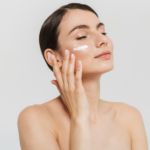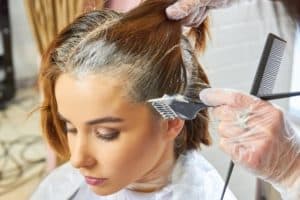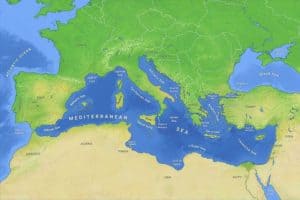You may have heard the term “alabaster,” but when it comes to skin tone, it can be hard to describe. What is alabaster skin tone?
Alabaster skin tone is considered to be a pure, fair white skin tone. It appears to be almost translucent from within, which is why many people consider this skin tone as a pale complexion that glows from the inside. The word “alabaster” came from alabastros, a Greek word that means “perfume vase.”
Read on to learn more about alabaster skin tone, including what it is and some picture examples of who has it.
Also, if you have alabaster skin tone, which is susceptible to redness, take a look at the Colorscience Clinical Redness Corrector Spectrum:
Click here to see it on Amazon.
Alabaster Skin Tone
Alabaster skin tone is extremely pale with a luminous quality. The word “alabaster” is derived from a fine-textured, compact, and white gypsum mineral called alabaster or alabastros in Greek. This mineral becomes translucent if it is cut into very thin sheets.
If you are wondering what alabaster skin tone looks like, look for pictures of famous celebrities like Scarlett Johansson, Anne Hathaway, Nicole Kidman, and Michelle Williams. These celebs are the perfect examples of people who have alabaster skin tones.
During the time of Elizabeth I in England, the vogue was to be so white-skinned even to the point where the skin is already dead-white. Their idea then was not to be deathly pale but to be as white as porcelain or ceramic. That was the fashion or what was in-style during those days.
Some people believed that this trend came about because the native English wanted to distinguish themselves from the Albanians and the Spaniards, who were slowly encroaching on their society.
Elizabeth I herself was always painted with a deathly alabaster skin tone because that was really the color of her skin.
Nowadays, when you say that a woman has an alabaster skin tone, you are really stating that she is very beautiful because of her white, very smooth, and glowing skin.
Celebrities with Alabaster Skin Tone
Below are some pictures of famous celebrities that will illustrate what an alabaster skin tone looks like.
1. Scarlett Johansson
Our first example is Scarlett Johansson, who stars in the film “Black Widow,” an offshoot of the “Avengers” franchise.

ID 172962441 © Featureflash | Dreamstime.com
2. Anne Hathaway
Our second example is Anne Hathaway, another famous celebrity who starred in many Hollywood blockbuster movies.

ID 175765054 © Featureflash | Dreamstime.com
3. Nicole Kidman
Our third example of a celeb that has an alabaster skin tone is Nicole Kidman. Here is a picture that shows her flawless skin:

Image credit: ID 175877881 © Featureflash | Dreamstime.com
The Difference Between Alabaster, Porcelain, and Ivory Skin Tone
Telling the difference between alabaster, porcelain, and ivory skin tones is not an exact science. Normally, it will depend on the colors of the foundation being used.
That means the actual difference will depend on which brand of the foundation is being considered. Some brands use numbers to define their colors, while other brands use their own unique names.
In other words, you can’t really come up with an exact way to figure out the difference between alabaster, porcelain, and ivory skin tones since they are all very white and light skin tones.
Perhaps one way to differentiate them is to grade them according to their levels of whiteness, that is, from the lightest white to the darkest white.
However, if you really want to have a handle on their differences, it helps to see their definitions side by side. Here are the general definitions of alabaster skin tone, porcelain skin tone, and ivory skin tone:
- Alabaster skin tone – Pale and creamy white with very fair and cool/neutral undertones.
- Porcelain skin tone – Very white and perfectly smooth without blemishes. It has fair and warm/yellow undertones.
- Ivory skin tone – White with a yellow tinge making it look like dusky white, with fair and warm/neutral pinkish or peachy undertones.
The Best Makeup and Clothing for an Alabaster Skin Tone
Possessing an alabaster skin tone is already a wonderful gift. You already have flawless, white skin that many people in Asia and the East are trying to emulate. However, if you’re not careful, your skin will make you look like you’re sick, even if you’re not.
Here are some things you can do to avoid looking pale or perhaps even sickly:
1) Colors to Wear for Your Skin Tone
Be careful about the colors of clothing that you will wear. Alabaster is really a white color. Most people with alabaster skin tones will display pink undertones on their skin. Therefore, you need to choose the right colors for your clothes.
The best colors to wear are light, sheer, and warm pastels with orange and pink undertones. If you are really daring and would like to accentuate your skin tone, wear bright red. But don’t wear purple as it could make your skin look bluish.
2) The Best Makeup for Alabaster Skin Tone
The best makeup shades for your alabaster skin tone include soft pink, beige, and tawny colors. Stay away from frosty finishes and red-orange makeup because they will make your skin appear washed out and sallow.
For your foundation, you can use nude or soft beige colors. You should also use the same colors for your concealer. Choosing the right blush might be a little more difficult but if you would like to look natural, choose coral, pearl, or soft pink.
You also need a bronzer for skin contouring. A sheer shade that hints at a soft shimmery pink or peach will add warmth to your cheeks. When applying a bronzer, just do it lightly and only add as needed.
For your eye shadow, the best would be earthly and bronze colors, especially if you have warm undertones. If you have cooler undertones, you can use metallic shades, gray, and jewel tones. For your lipstick, the best colors for your alabaster skin are pink, red, and nude.
Skin Care for Alabaster Skin Tone
If you have an alabaster skin tone, you have a sensitive type of skin that demands special care and attention.
1. Sunscreen Protection
Fair white skin, like alabaster skin tone, is more likely to get sun damaged. Your skin is prone to skin damage from UV exposure. For this reason, it would be essential to have good sunscreen protection all year round.
2. Soothing Cream
Your skin is also prone to redness. Use a calming and soothing cream to prevent your skin from turning red. If in case your skin turns red, you can use the Colorescience All Calm Clinical Redness Corrector.
Click here to see it on Amazon.
This 3-in-1 formula instantly neutralizes skin redness and helps soothe your sensitive skin. It also provides UV protection for your skin with its broad-spectrum SPF 50.
3. Concealer
Use a concealer that has a green tint to hide the redness of your skin caused by broken capillaries or pimples.
4. Hats
Do you get sunburned easily? If you do, you have to wear a hat whenever you are going out, especially if it is a sunny day. It doesn’t take much UV exposure to damage your skin.
5. Facial Cleanser
Cleanse your face once in the morning and once before going to bed. Do not use face cloths and harsh soaps in cleaning your face because they may be too rough for your sensitive alabaster skin. Use skin or facial cleansers that contain natural ingredients.
The ZO Skin Health Offects Exfoliating Cleanser is a very gentle cleanser that gives your skin that fresh and clean feeling without making it dry.
Click here to see it on Amazon.
6. Oil Control
If your alabaster skin is oily, you can use a face primer together with several oil blotting sheets that are designed for people with oily skin. However, only use the primer on the spots where it is needed. Normally, it is only applied on the chin, nose, forehead, and the T-zone.
7. Self-tanning Routine
If you want your skin to be darker, don’t visit a solarium or expose yourself to the sun. Direct exposure to the sun for extended hours will dry your skin. Your skin will develop fine lines, premature wrinkles, and age spots. They will show up easily on your skin because of their pure whiteness.
There is a safer and easier way to get the tan that you want. Use a self-tanning formula instead.
The Tan Towel Self Tan Towelette Classic can be used for this purpose. You will have direct control over the degree of tan that you will get. You can also apply it gradually and stop it once you have acquired the right tan.
Click here to see it on Amazon.
8. Egg Facial Mask
You can also use an egg yolk to make your own facial mask. Egg yolks contain nutrients, proteins, and vitamins that are good for your sensitive skin. To turn an egg yolk into a face mask, you need to separate the yolk from the egg white.
Set aside the egg white. Mix a tablespoon of almond oil together with the egg yolk. If you don’t have almond oil, you can use olive oil instead.
Apply the egg and oil mixture on your face, and let it stay for about five minutes. Your skin will be nourished and rejuvenated by this homemade face mask. After five minutes, gently splash some warm water on your face.
Next, get the egg white and apply it to your face. Let it settle for another three to five minutes to help tighten your skin and make it brighter. Gently rinse your face with warm water. You will feel that your skin feels fresh, rejuvenated, and nourished.
9. Handwashing
Don’t touch your face with unwashed hands. Your alabaster skin is very sensitive to irritants, even the mild types. If you touch your face with a dirty hand, the bacteria or germs that you have unintentionally carried in your hands while touching sundry things can infect your sensitive skin.
Regular handwashing takes a lot of practice and discipline if you are used to touching your face throughout the day.
10. See a Dermatologist
Do you have excessive redness on your face because of sunburn or pimples? Don’t just cover it with concealers. You need to ask the help of your dermatologist. He or she has the right solution that will take care of the redness and prevent it from worsening.
No matter what type and how much foundation, concealer, or makeup you apply on your alabaster skin, you won’t achieve a gorgeous look if your skin underneath is not healthy and vibrant.
Think of your skin as a clean canvass, which is your basic foundation material where you can create a beautiful work of art.
The key to having that gorgeous alabaster visage is to look natural as much as possible. Only use a foundation with the right color, consistency, and texture for your alabaster skin. Then, follow the tips given above when choosing the types of foundation, lipstick, and eye makeup.
Always get the right amount of rest and sleep. A healthy diet and regular hydration will also go a long way in having that stunning alabaster look. Moreover, only use face and skincare products, which contain ingredients that are safe, natural, and organic to avoid irritation and other skin troubles.
Conclusion – Alabaster Skin Tone
So, what is alabaster skin tone, and what does it look like? Alabaster skin tone is basically very white skin with some hues of porcelain and ivory. People with clear, even, bright-white skin are said to have alabaster skin.
It is considered flawless, even-toned, bright white skin. Celebrities with alabaster skin tone include Scarlett Johansson, Anne Hathaway, Nicole Kidman, and Michelle Williams.
Being extremely white, it needs a bit of special care to help it remain that way. Sunscreen is very important. A good moisturizer is also important to avoid drying up during the colder months. If the alabaster skin tone is too white, there are many self-tanning products available to try.
Related reading:
What Is Pale Skin Tone? (With Pictures)
Pale Skin and Black Hair for Caucasians





![Golden Brown Skin Tone - What Is It? [With Pictures] golden brown skin](https://skincaregeeks.com/wp-content/uploads/2021/04/golden-brown-skin-150x150.jpg)

![Neutral Skin Tone Defined [and Best Colors for Neutral Skin] neutral skin tone](https://skincaregeeks.com/wp-content/uploads/2021/05/neutral-skin-tone-150x150.png)





